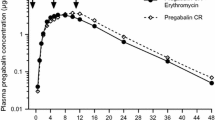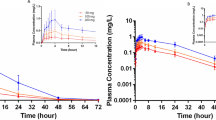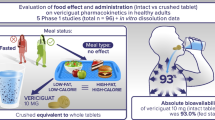Abstract
The effect of pH on the buccal and sublingual absorption of captopril was evaluated using in vitro techniques and human studies. Partitioning of captopril into n-octanol was lowest over the pH range 5 to 8 and highest at pH values 3, 4 and 9. Using the buccal absorption technique, the partitioning of captopril (2 mg) was examined in six healthy male volunteers from buffered solutions (pH 3, 4, 5, 6, 7, 8, and 9). Lowest buccal partitioning occurred at pH 3 while maximal buccal partitioning occurred at pH 7. These data clearly indicated that the buccal absorption of captopril did not obey the classical pH/partition hypothesis suggesting that mechanisms other than passive diffusion were involved in its absorption. Captopril pharmacokinetic and pharmacodynamic parameters were determined after administration of buffered sublingual captopril (pH 7, optimal pH for absorption as determined from the buccal partitioning data) and unbuffered sublingual captopril. The study was performed in eight healthy volunteers in a randomised single-blind cross-over fashion. The tmax for captopril was found to be approximately 11 minutes earlier after buffered versus unbuffered sublingual administration and AUC0–30 min increased by approximately 30% in the case of buffered captopril. Cpmax, AUC0–180 min and relative bioavailability did not differ between the buffered and unbuffered administration. Pharmacodynamic parameters (BP, heart rate and plasma renin activity) did not differ significantly between buffered and unbuffered sublingual administration. The increased rate of captopril absorption after buffered sublingual administration was small and is likely to offer little therapeutic advantage over conventional sublingual formulation.
Similar content being viewed by others
References
Beckett AH, Triggs EJ (1987) Buccal absorption of basic drugs and its application as an in vivo model of passive drug transfer through lipid membranes. J Pharm Pharmacol 19:31s-41s
Ohman KP, Kagedal B, Larsson R, Karlberg BE (1985) Pharmacokinetics of captopril and its effects on blood pressure during acute and chronic administration and in relation to food intake. J Cardiovasc Pharmacol 1985 7:S20-S24
Al-Furaih TA, McElnay JC, Elborn JS, Rusk R, Scott MG, McMahon J, Nicholls DP (1991) Sublingual captopril — a pharmacokinetic and pharmacodynamic evaluation. Eur J Clin Pharmacol 40:393–398.
Komsuoglu B, Sengun B, Bayram A, Komsuoglu SS (1991) Treatment of hypertensive urgencies with oral nifedipine, nicardipine and captopril. Angiology 42:447–454
Angeli P, Chiesa M, Caregaro L, Merkel C, Sacerdoti D, Rondana M, Gatta A (1991) Comparison of sublingual captopril and nifedipine in immediate treatment of hypertensive emergencies. A randomized, single-blind clinical trial. Arch Intern Med 151:678–682
Wu SG, Lin SL, Shiao WY, Huang HW, Lin CF, Yang YH (1993) Comparison of sublingual captopril, nifedipine and prazosin in hypertensive emergencies during hemodialysis. Nephron 65:284–287
Jain NB (1986) Captopril In: Connors KA, Amidon GL, Stella VJ (eds) Chemical stability of pharmaceuticals, a handbook for pharmacists. Wiley, New York pp 284–289
Perrett D, Drury PL (1982) The determination of captopril in physiological fluids using high performance liquid chromatography with electro-chemical detection. J Liquid Chromatogr 5:97–110
Kawahara Y, Hiaoka M, Yamazaki Y, Inage A, Morioka T (1981) Determination of captopril in blood and urine by high performance liquid chromatography. Chem Pharm Bull 29:150–157
Seta Y, Hignchi F, Kawahara Y, Nishimura K, Okada R (1988) Design and preparation of captopril sustained-release dosage forms and their biopharmaceutical properties. Int J Pharm 41:245–254
Ranadive SA, Chen AX, Serajuddin ATM (1992) Relative lipophilicities and structural-pharmacological considerations of various angiotensin-converting enzyme (ACE) inhibitors. Pharm Res 9:1480–1486
Florence AT, Attwood D (1987) Solubility of drugs in liquids. In: Physico-chemical principles of pharmacy. MacMillan, London, pp 158–160
McElnay JC, Temple DJ (1982) The use of buccal partitioning as a model to examine the effects of aluminium hydroxide gel on the absorption of propranolol. Br J Clin Pharmacol 13:399–403
Kirschbaum J, Perlman S (1984) Analysis of captopril and hydrochlorothiazide combination tablet formulations by liquid chromatography. J Pharm Sci 73:686–687
Pereira CM, Tam YK (1988) Simplified determination of captopril in plasma by high performance liquid chromatography. J Chromatogr 425:208–213
Haycock KA, Roth J, Gagnon J, Finzer WF, Soper C (1992) Statview. The ultimate integrated data analysis and presentation system. Abacus Concepts, Berkeley, pp 322–323
Harris D, Robinson JR (1992) Drug delivery via the mucous membranes of the oral cavity. J Pharm Sci 91:1–10
Haude M, Steffen W, Erbel R, Meyer J (1990) Sublingual administration of captopril versus nitroglycerin in patients with severe congestive heart failure. Int J Cardiol 27:351–359
Haude M, Erbel R, Steffen W, Tschollar W, Meyer J (1991) Sublingual administration of captopril in patients with acute myocardial ischemia. Clin Cardiol 14:463–468
Kadin H (1982) Captopril In: Florey K, Analytical profiles of drug substances. Academic Press, New York, p 53
Beckett AH, Moffat AC (1969) Correlation of partition coefficients in n-heptane aqueous systems with buccal absorption data for a series of amines and acids. J Pharm Pharmacol 21:144s-150s
Hu M, Amidon GL (1988) Passive and carrier-mediated intestinal absorption components of captopril. J Pharm Sci 77:1007–1011
Tamai I, Ling H-Y, Timbul S-M, Nishikido J, Tsuji A (1988) Stereospecific absorption and degradation of cephalexin. J Pharm Pharmacol 40:320–324
Author information
Authors and Affiliations
Rights and permissions
About this article
Cite this article
McElnay, J.C., Al-Furaih, T.A., Hughes, C.M. et al. The effect of pH on the buccal and sublingual absorption of captopril. Eur J Clin Pharmacol 48, 373–379 (1995). https://doi.org/10.1007/BF00194953
Received:
Accepted:
Issue Date:
DOI: https://doi.org/10.1007/BF00194953




